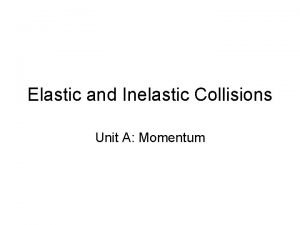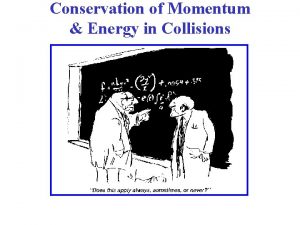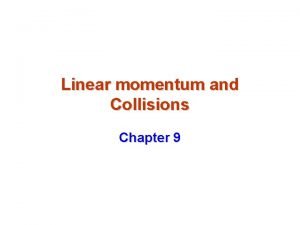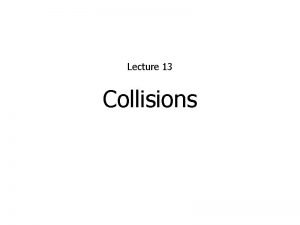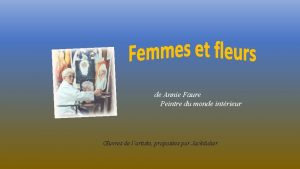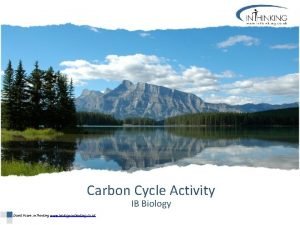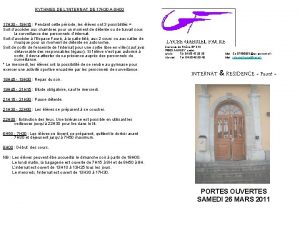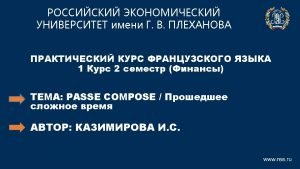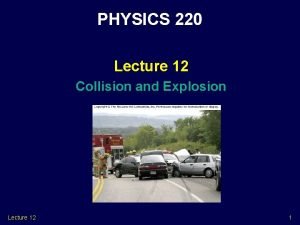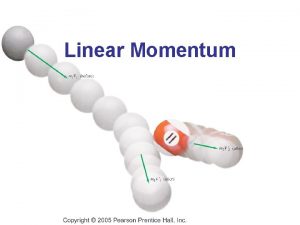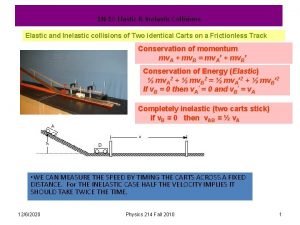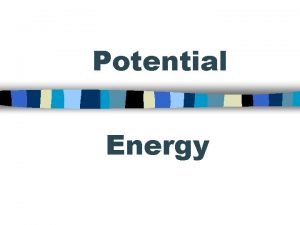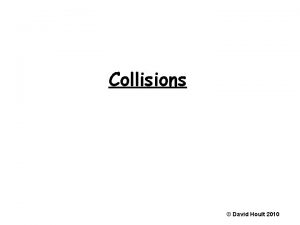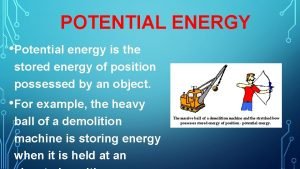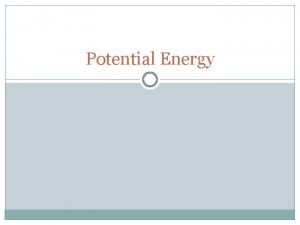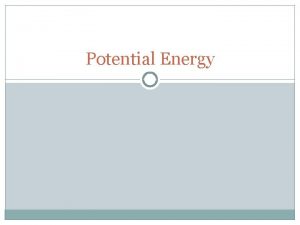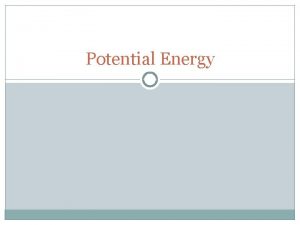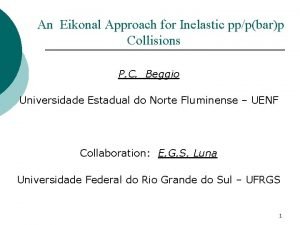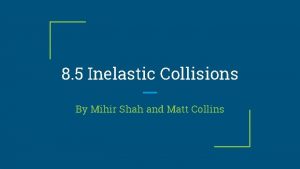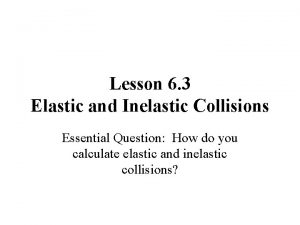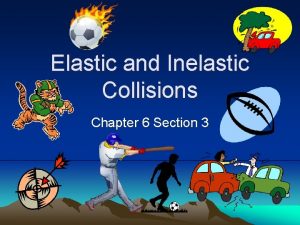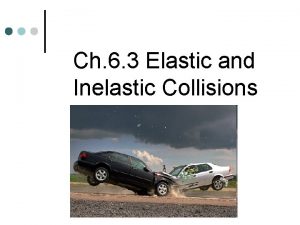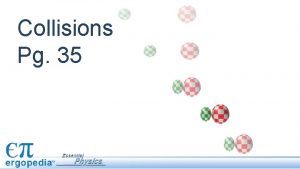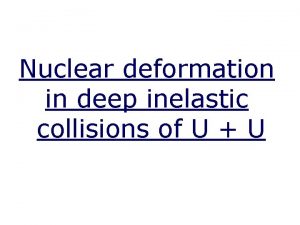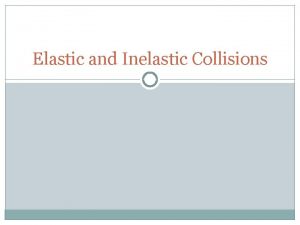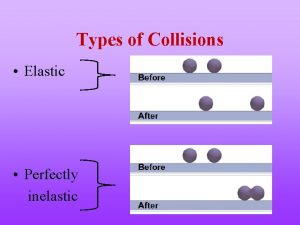Potential energy surfaces for inelastic collisions Alexandre Faure


















































- Slides: 50

Potential energy surfaces for inelastic collisions Alexandre Faure, Claire Rist, Yohann Scribano, Pierre Valiron, Laurent Wiesenfeld Laboratoire d’Astrophysique de Grenoble Mathematical Methods for Ab Initio Quantum Chemistry, Nice, 14 th november 2008

Outline 1. Astrophysical context 2. Determining, monitoring and fitting multidimensional PESs 3. Computing scattering cross sections 4. Conclusions

1. Molecules in space

New windows on the « Molecular Universe » Herschel (2009) 490 5000 GHz ALMA (2010) 30 950 GHz

RTN FP 6 « Molecular Universe » (2004 -2008)

Astrochemistry ? 1. 90% hydrogen 2. Low temperatures (T = 10 – 1, 000 K) 3. Ultra-low densities (n. H ~ 103 -1010 cm-3). Astronomer’s periodic table, adapted from Benjamin Mc. Call

A very rich chemistry ! Smith (2006)

Molecules as probes of star formation Lada et al. (2003)

Challenge: modelling non-LTE spectra Aij ~ Cij J(J+1)B Rotational energy Electric-dipolar transitions obey strict selection rules: J = 1 l Collisional transitions obey « propensity » rules: J = 1, 2, etc. J=3 12 B radiative 6 B l collisional J=2 2 B J=1 0 J=0

Wanted: Collisional rate coefficients l M(j, v) + H 2(j 2, v 2) M(j’, v’) + H 2(j 2’, v 2’) l Collision energies from ~ 1 to 1, 000 cm-1, i. e. rotational excitation dominant l As measurements are difficult, numerical models rely on theoretical calculations.

2. Computing PESs

Born-Oppenheimer approximation l Electronic problem l Nuclear problem l Orbital approximation l « Electronic » PES l Hartree-Fock (variational principle) l Quantum dynamics: closecoupling, wavepackets l Electronic correlation (configuration interaction) l Semi or quasi-classical dynamics: trajectories

Electronic structure calculations Improving electronic correlation Full CI Improving the basis set Hartree. Fock Infinite Hartreebasis Fock limit « Exact » solution

van der Waals interactions l The interaction energy is a negligible fraction of molecular energies: E(A-B) = E(AB) – E(A) –E(B) l For van der Waals complexes, the bonding energy is ~ 100 cm-1 l Wavenumber accuracy (~ 1 cm-1) required !

State-of-the-art: R 12 theory

CO-H 2 R 12 versus basis set extrapolation Wernli et al. (2006)

H 2 O-H 2 Towards the basis set limit Double quality R 12 Faure et al. (2005); Valiron et al. (2008)

H 2 O-H 2 ab initio convergence Ab initio minimum of the H 2 O-H 2 PES as a function of years

Computational strategy l l where Faure et al. (2005); Valiron et al. (2008)

Expanding 5 D PES

In preparation l Scalar products : l Sampling « estimator » : l Mean error:

Convergence of ||S-1|| (48 basis functions) Rist et al. , in preparation

Convergence of ei (48 basis functions) Rist et al. , in preparation

Application to H 2 O-H 2 wavenumber accuracy ! Valiron et al. (2008)

2 D plots of H 2 O-H 2 PES Valiron et al. (2008)

Equilibrium vs. averaged geometries The rigid-body PES at vibrationally averaged geometries is an excellent approximation of the vibrationally averaged (full dimensional) PES Faure et al. (2005); Valiron et al. (2008)

Current strategy l Monomer geometries: ground-state averaged l Reference surface at the CCSD(T)/aug-cc-p. VDZ (typically 50, 000 points) l Complete basis set extrapolation (CBS) based on CCSD(T)/aug -cc-p. VTZ (typically 5, 000 points) l Monte-Carlo sampling, « monitored » angular fitting (typically 100 -200 basis functions) l Cubic spline radial extrapolation (for short and long-range)

H 2 CO-H 2 Troscompt et al. (2008)

NH 3 -H 2 Faure et al. , in preparation

SO 2 -H 2 Feautrier et al. in preparation

HC 3 N-H 2 «Because of the large anisotropy of this system, it was not possible to expand the potential in a Legendre polynomial series or to perform quantum scattering calculations. » (S. Green, JCP 1978) Wernli et al. (2007)

Isotopic effects: HDO-H 2 =21. 109 o Scribano et al. , in preparation

Isotopic effects: significant ? Scribano et al. , in preparation

2. Scattering calculations

Close-coupling approach Schrödinger (time independent) equation + Born-Oppenheimer PES Total wavefunction Cross section and S-matrix S 2 = transition probability

Classical approach Hamilton’s equations Cross section and impact parameter Statistical error Rate coefficient (canonical Monte-Carlo)

CO-H 2 Impact of PES inaccuracies Wernli et al. (2006)

CO-H 2 Impact of PES inaccuracies l Inaccuracies of PES are NOT dramatically amplified l Wavenumber accuracy sufficient for computing rates at T>1 K l Lapinov, private communicqtion, 2006 Note: the current CO-H 2 PES provides subwavenumber accuracy on rovibrational spectrum ! (see Jankowski & Szalewicz 2005)

H 2 O-H 2 Impact of PES inaccuracies Phillips et al. equilibrium geometries CCSD(T) at equilibrium geometries CCSD(T)-R 12 at averaged geometries Dubernet et al. (2006)

H 2 O-H 2 Ultra-cold collisions Scribano et al. , in preparation

Isotopic effects Yang & Stancil (2008) Scribano et al. , in preparation

HC 3 N-H 2 Classical mechanics as an alternative to close-coupling method ? T=10 K

l o-H 2/p-H 2 selectivity due to interferences l Rotational motion of H 2 is negligible at the QCT level l As a result, o-H 2 rates are very similar to QCT rates T=10 K T=100 K Wernli et al. (2007), Faure et al. , in preparation


Faure et al. (2006)

Experimental tests l Total (elastic + inelastic) cross sections l Differential cross sections l Pressure broadening cross sections l Second virial coefficients l Rovibrational spectrum of vd. W complexes

CO as a benchmark T=294 K T=15 K Carty et al. (2004) Jankowski & Szalewicz (2005)

H 2 O-H 2 total cross sections Cappelletti et al. , in preparation

H 2 O-H 2 differential cross sections max para 000→ 111 H 2 O min Ter Meulen et al. , in preparation

Conclusions l Recent advances on inelastic collisions l l l PES l Ab initio: CCSD(T) + CBS/R 12 l Fitting: Monte-Carlo estimator Cross section and rates l Wavenumber accuracy of PES is required but sufficient l Success and limits of classical approximation Future directions l l « Large » polyatomic species (e. g. CH 3 OCH 3) Vibrational excitation, in particular « floppy » modes
 Elastic vs inelastic vs perfectly inelastic
Elastic vs inelastic vs perfectly inelastic Elastic vs inelastic
Elastic vs inelastic Perfectly elastic collision
Perfectly elastic collision Collision and its types
Collision and its types Electrostatic potential difference
Electrostatic potential difference Electrostatic potential energy definition
Electrostatic potential energy definition Electric potential and potential energy
Electric potential and potential energy How to find kinetic energy lost in inelastic collision
How to find kinetic energy lost in inelastic collision Annie faure peintre
Annie faure peintre Annie faure peintre
Annie faure peintre Annie faure peintre
Annie faure peintre Annie faure peintre
Annie faure peintre Annie faure peintre
Annie faure peintre Serge faure
Serge faure Annie faure peintre
Annie faure peintre Carbon cycle drag and drop
Carbon cycle drag and drop Lycée gabriel fauré annecy internat
Lycée gabriel fauré annecy internat Faure passe compose
Faure passe compose Energy formula
Energy formula How can mechanical energy be conserved
How can mechanical energy be conserved What is the definition of chemical potential energy
What is the definition of chemical potential energy Energy is the ability to
Energy is the ability to Gravitational potential energy vs kinetic energy
Gravitational potential energy vs kinetic energy The law of conservation of energy states that
The law of conservation of energy states that Potential energy meaning
Potential energy meaning The change in mechanical energy
The change in mechanical energy Kinetic energy and potential energy formula
Kinetic energy and potential energy formula The change in mechanical energy
The change in mechanical energy Why is water potential measured in pascals
Why is water potential measured in pascals Osmotic potential vs water potential
Osmotic potential vs water potential Solute potential equation
Solute potential equation Graded potential vs action potential
Graded potential vs action potential Nerve action potential
Nerve action potential Characteristics of graded potential
Characteristics of graded potential Graded vs action potential
Graded vs action potential Graded potential vs action potential
Graded potential vs action potential Osmotic potential vs water potential
Osmotic potential vs water potential Sources of biopotential
Sources of biopotential Transmission across a synapse
Transmission across a synapse End-plate potential vs action potential
End-plate potential vs action potential Action potential resting potential
Action potential resting potential Action potential resting potential
Action potential resting potential Market potential and forecasting
Market potential and forecasting Define electric potential and potential difference.
Define electric potential and potential difference. Electric potential and potential difference
Electric potential and potential difference Electric potential and potential difference
Electric potential and potential difference Electric potential
Electric potential A freight train is being assembled in a switching yard
A freight train is being assembled in a switching yard An estimated force time curve for a baseball
An estimated force time curve for a baseball Inelastic collision examples
Inelastic collision examples Elasticity measures
Elasticity measures
